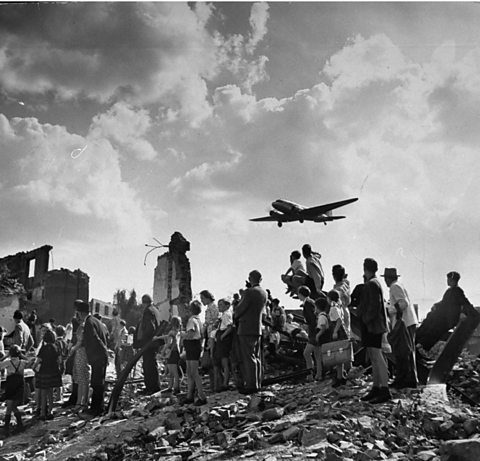Berlin Blockade and Berlin Airlift, 1948-49
Learn more about the Berlin Blockade and Airlift in this podcast.
Listen to the full series on BBC Sounds.
Background
Ever since the Yalta Conference, it had been clear that Berlin was going to be a flash point in the Cold War, and this came to a head in 1948.
- Germany had been divided into four zones of occupation each controlled by one of the Allies.
- The German capital, Berlin, lay inside the Russian zone and was also divided into four zones of occupation.
- Access to Berlin for the Allies was by way of road, rail and canal, and via three specific air corridors.
What caused the Berlin Blockade?
Stalin wanted Germany to remain weak, unthreatening and as a ‘buffer zoneAn area giving someone protection against a threat, e.g. the USSR wanted a buffer zone around them after being invaded by Germany in both World Wars.’ between it and the West. He rapidly lost patience with the way the West were acting in Berlin and decided to push them out.
What were the Western Allies doing in Berlin that made Stalin so upset?
- Using money from the Marshall Aid programme, the Allies were helping the Germans to rebuild their economy – they had learnt their lesson from the Treaty of VersaillesThe peace treaty signed by the Allies and Germany at the end of the First World War, on 28 June 1919. and did not want to make Germany financially crippled again. This meant introducing a new, stable currency and more jobs for workers in the Western sectors. Stalin was angered by this.
- Under the Marshall Plan, the USA supplied goods to German shops for workers to buy. This was a nice way of showing the communists that America’s capitalist economy was flourishing.
- At a meeting in London in January 1948, Britain and the USA joined their zones together to create ‘Bizonia’ and make it easier to administer them. (France would later join and they’d change the name to West Germany).
On 24th June 1948, Stalin cut all land access to Berlin for the Allies. This became known as the Berlin Blockade.
"Cabinet discuss crisis in Berlin"
What did the Berlin Blockade mean for West Berlin?
- Berlin could now only be accessed by air, resulting in a restriction on the freedom to travel outside Berlin for all Germans.
- A shortage of food - West Berlin only had enough food for 36 days.
- A lack of basic goods like fuel and medicines.
The Reaction of the Western Allies

The Berlin Blockade was the first real test for the American policy of containmentAn American policy to try and stop communism from spreading, to restrict it from spreading to other countries.. As forcing their way into the city by land could have led to another war, the Allies decided that their sectors of Berlin would be supplied by air. This became known as the Berlin Airlift and it lasted for eleven months until the Blockade was lifted in May 1949.
At the height of the Berlin Airlift, a plane landed at Berlin’s Templehof Airport every minute. Keeping West Berlin supplied in this way cost the USA $350 million and Britain £17 million.
Stalin was powerless to stop the Berlin Airlift. To shoot down the planes could have provoked World War Three, and at this stage, unlike the USA, the USSR did not have nuclear weapons.
The Aftermath of the Berlin Blockade
- Berlin would remain a source of tension in Europe for the duration of the Cold War.
- In April 1949 the USA, Britain and France officially announced the formation of the German Federal Republic (West Germany).
- Elections in the Germany Federal Republic in August 1949 resulted in victory for the anti-communist politician, Konrad Adenauer, and the Christian Democratic Union.
- The formation of NATO (the North Atlantic Treaty Organisation) in April 1949 – an alliance of countries around the North Atlantic for their mutual defence.
- The USSR responded to the formation of NATO with the Warsaw Pact in May 1955– similarly an alliance of the communist countries of Eastern Europe for their mutual defence.
- Finally, on 29 August 1949, the USSR exploded its first atomic bomb. The USA no longer had a monopolyA market where there is only one seller of a particular good or service. on nuclear weapons.
Revision tip
Generally, all Western actions were matched by the USSR. Learn the pairs and their dates!
Politics: Truman Doctrine (1947) vs Cominform (1947)
Economics: Marshall Plan (1948) vs Comecon (1949)
Military: NATO (1949) vs Warsaw Pact (1955)